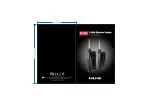
6
Safety Information
Thermo Scientific
NanoDrop One
C
with NanoDropQC Software User Guide
139
The following solvents are compatible for use on the
pedestals
of all NanoDrop instruments.
It is recommended that all corrosive solvents be wiped from the pedestal immediately upon
completion of a measurement. It is also recommended that the user end a series of
measurements with a dH
2
O sample to ensure that solvents are not inadvertently left on the
pedestal.
The diaphragm around the pedestal of the NanoDrop is permanently affixed to the
instrument. Do not attempt to remove the diaphragm or break the seal. Avoid prolonged
exposure of the diaphragm to HCl, alcohol, bleach, acetone or other solvents as the adhesive
securing the seal may be affected. If the seal comes loose please contact us.
Biohazard or Radioactive Materials and Infectious Agents
Biological samples such as tissues, body fluids, infectious agents, and blood of humans and
other animals have the potential to transmit infectious diseases. Wear appropriate protective
equipment. Individuals should be trained according to applicable regulatory and organization
requirements before working with potentially infectious materials. Follow your organization’s
Biosafety Program protocols for working with and/or handling potentially infectious
materials.
NOTICE
Spillage of these solvents on surfaces other than the pedestals may damage the
instrument.
• methanol
• ethanol
• n-propanol
• isopropanol
• butanol
• acetone
• ether
• chloroform
• carbon tetrachloride
• DMSO
• DMF
• acetonitrile
• THF
• toluene
• hexane
• benzene
• sodium hydroxide
• sodium hypochlorite (bleach)
• dilute HCl
• dilute HNO
3
• dilute acetic acid
NOTICE
All forms of Hydrofluoric Acid (HF) are incompatible as the fluoride ion will
etch the fiber optic cable.


































